WWI WAS SUPPOSED TO END IN SEPTEMBER 1918 WITH THE DOUGHBOYS LIBERATING METZ, AND THEN ON TO FINAL VICTORY IN BERLIN. INSTEAD, THEY WERE DIVERTED TO A KILLING ZONE CALLED THE ARGONNE FOREST, WHICH WAS FORTIFIED WITH THOUSANDS OF DEADLY VICKERS-MAXIM-KRUPP MACHINE GUNS!! |
This expose will make all previous histories of World Wars I & II obsolete . . . or gone with the wind . . . because Generalissimo Joseph Stalin, and U.S. Army Chief of Staff General George C. Marshall were British Secret Service agents!
The Armistice was set to take effect at the 11th hour, of the 11th day, of the 11th month of the year....November 11, 1918. . When it was first announced in the trenches the Doughboys were not exactly sure what ARMISTICE meant. Was if just a temporary truce or a permanent cease fire? The shelling continued on both sides up to the very last minute.
When it became apparent that ARMISTICE meant a permanent CEASEFIRE, many of the brave New Jerusalem soldiers were bitterly disappointed. Berlin was their final destination, and they had been cheated out of victory at the 11th hour. As for the Prussians, they returned to Germany with heads held high and bands playing!
General John J. Pershing was in charge of the American Expeditionary Force (AEF). The Doughboys arrived in France without arms and ammunition, especially their excellent Springfield rifles....All of their rifles, artillery, and tanks were supplied by the French and British.
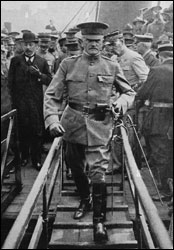 General Pershing arriving in France to rescue Europe from the Second Reich, June 13, 1917. |
|
 General John Joseph Pershing (1860–1948). |
The British and French were adamantly opposed to an American Army operating under an American commander. They saw the Doughboys as replacements for the hundreds of thousands of their own cannon fodder that had perished in the trenches.
They also believed that creating an independent army, 3,000 miles from home, was beyond General Pershing's capabilities.
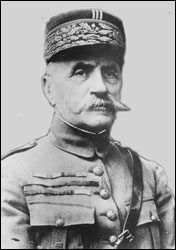 Marshal Ferdinand Foch (1851–1929). |
|
 Field Marshal Douglas Haig (1861–1928). |
After several confrontations with Foch and Haig, General Pershing finally had his American Army ready for battle. The first objective was a bulge in the German lines called the St. Mihiel salient.
 Renault tanks were driven by Americans. Renault tanks were driven by Americans. |
|
 Columns of Boche prisoners surrendering Columns of Boche prisoners surrendering on the first day of the Battle of St. Mihiel. |
The British invented the tank, but their tanks were clumsy behemoths, and often bogged down in waterlogged shell craters, which rendered them useless!
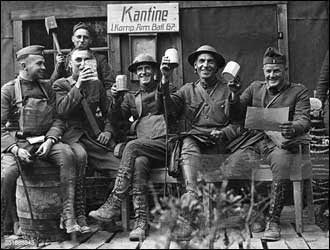 "Soldiers of liberty" enjoying German beer "Soldiers of liberty" enjoying German beerin front of a captured canteen. |
|
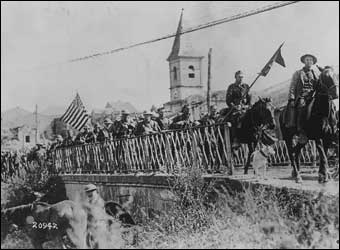 "Soldiers of liberty" returning
"Soldiers of liberty" returningtriumphantly after the battle. |
German losses were about 18,000 killed and wounded, with 10,000 prisoners, and 450 artillery pieces.
Before Foch the fossil would agree to an independent American Army, he made Pershing agree to mount an offensive in the heavily fortified Meuse-Argonne area. However, with the success of the St. Mihiel offensive, Pershing knew that the battlefield situation had changed completely:
It occurred to Pershing that he could simply ignore the agreement with Foch. The Meuse-Argonne drive was not expected to progress very far before winter; the drive was viewed as a preliminary to large-scare operation in the spring of 1919. On the other hand, exploitation of the success at St. Mihiel would yield immediate results by threatening the Briey Iron Basin and the critical railway net beyond Metz. Such opportunities were rare indeed, and it seemed foolish to reject it in favor of an operation planned under completely different circumstances. (Hallas, Squandered Victory, p. 194).
General Pershing graduated from the West Point Military Academy, but recognizing spies and secessionists was not part of the "war" college curriculum!
 Colonel Walter Snake Grant (1878–1956). |
|
 Colonel George Cunning Marshall (1880–1956). |
Pershing received the worst kind of defeatist advice from the 2 secret agents:
That evening Pershing put the suggestion to his operations staff. Colonels George C. Marshall and Walter S. Grant were vigorously opposed to continuing the action. The attack had lost its momentum, they argued in a joint statement. The enemy had been given enough time to reform scattered units and bring up reserves. By their calculations, it would take at least 12 hours to renew the attack, giving the Germans even more time to prepare. And finally, they noted, as Pershing already knew, the renewed advance would make it impossible to concentrate American divisions in the Meuse-Argonne by the agreed upon time (Hallas, Squandered Victory, p. 194).
General Pershing followed the advice of the 2 secret agents, and the result was the deadliest battle in U.S. history.
The Meuse-Argonne offensive was the deadliest battle in U.S. history!!
The Meuse-Argonne offensive was one continuous battle that lasted from September 26 to the Armistice on November 11. Total U.S. casualties number 26,000 killed, and over 100,000 wounded.
 "Dead Head" Crown Prince Wilhelm (1882–1951). |
|
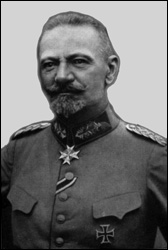 General Max von Gallwitz (1852–1937). |
That logistical nightmare involved moving 400,000 soldier's from the St. Mihiel battlefield 60 miles (96 km) north to the Argonne Forest:
The more Marshall nagged at the problem, the more confused he became. He would have to pull fifteen divisions out of the line, replacing them with 200,000 French troops, then move the Americans, their French manned artillery, their supplies, field kitchens, hospitals, and headquarters, sixty miles over dreadful roads at closely timely intervals, yet keep the migration from snarling in a great tangle (Cray, General of the Army George C. Marshall, p. 71).
Not one example from history ever existed where troops fighting one battle were pulled out according to a pre-set plan to immediately fight another battle. To compound the problem the move had to be made at night without lights, because even a light from a cigarette would invite ever watchful Boche artillery fire!
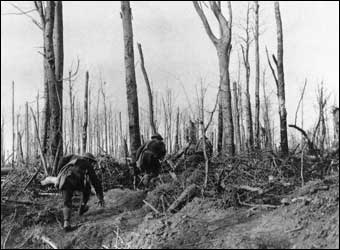 U. S. Marines advancing against heavily fortified Boche positions. |
|
 A hellish, well entrenched Hun using a flamethrower against advancing Marines. |
To the great dismay of Confederates Marshall and Grant, the Doughboys accomplished the impossible. Instead of waiting for the artillery to smash the barbed wire, they leaped over it like soldiers with winged feet....The French called them "Supermen," and even the "Butcher of the Somme" was "surprised" at the rapidity of their advance against suicidal Hunnish resistance!
 The deadly Vickers-Maxim-Krupp machine guns were ubiquitous in the Argonne Forest. |
|
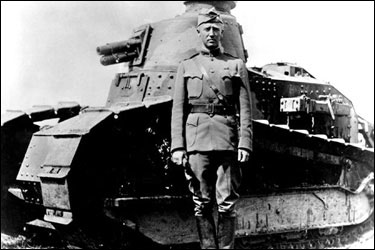 Colonel George S. Patton was wounded leading Colonel George S. Patton was wounded leading a tank brigade during the offensive. |
For his heroic action, Private Angelo was awarded the Distinguished Service Cross. The loss of General Patton could have changed the outcome of World War II.
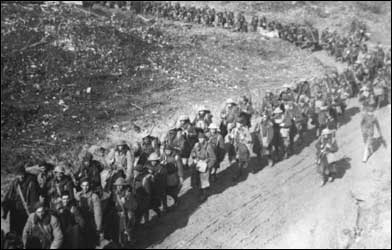 The "soldiers of liberty" marching to Sedan after breaking through the Argonne Forest. |
|
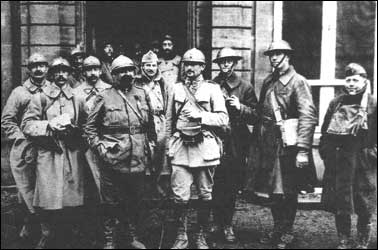 The French and Americans shared the glory when Sedan was finally liberated on November 9. |
On September 20, 1870, Roma was liberated, and that began an historic countdown to the coming of the King of Kings. Except for the Marines, most of the "soldiers of liberty" were green troops, with very little basic training. The secret of their success was the fact that no matter how many were mowed down by the Maxims . . . they just kept on coming....That was what finally convinced "Kaiser Bill" to cry "Uncle! Sam."
Army Chief of Staff Marshall prevented General Patton from capturing Berlin in September 1944
History does repeat itself in incredible ways. The very man who diverted the American Army to the deadly Mouse-Argonne offensive was Army Chief of Staff under FDR. Thanks to friends like Lord Halifax and Churchill, Marshall the spy was able to climb to the very top of the military chain of command.
After leading an American blitzkrieg across France, General Patton was approaching the Loraine region of France. That area was thoroughly familiar to him from WWI.
 General George Cunning Marshall (1880–1959). |
|
 General George C. Marshall and General Patton examining a model of Fortress Metz. General George C. Marshall and General Patton examining a model of Fortress Metz. |
Marshall and Grant wanted to give Hitler time to develop nuclear weapons that would turn defeat into victory at the 11th hour!
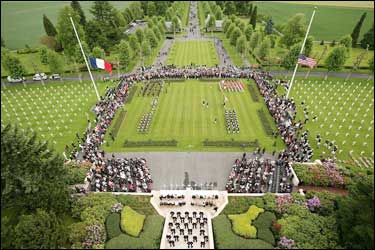 About 3,000 Marines await the Last Trumpet at the Belleau Wood cemetery. |
|
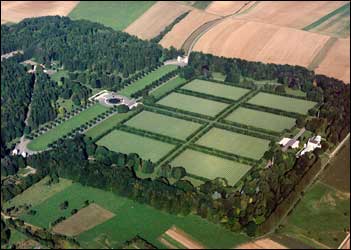 Aerial view of the Meuse-Argonne American cemetery, where 14,000 "soldiers of liberty" await the Last Trumpet. |
General George C. Marshall, the man who was responsible for the deadly Meuse-Argonne offensive, never set foot in either cemetery!
The world owes and incalculable debt of gratitude to the brave American "soldiers of liberty" who defeated the Prussians, and saved Christian civilization from extinction.
If the Doughboys had failed in France, there was a diabolical plot to invade the New Jerusalem from Mexico. Battalions of British Empire mercenaries, disguised as Germans, were already on standby to do just that. They would have received a very enthusiastic welcome from the Confederates in the South!
That would have meant the end of the New Jerusalem, with Antichrist planting his tabernacle from sea to shining sea (Daniel 11:45).
Vital links
References
Cray, Ed. General of the Army George C. Marshall. W. W. Norton & Company, New York, 1990.
Hallas, James H. Squandered Victory: The American First Army at St. Mihiel. Praeger Publishers, Westport, Connencticut, 1995.
Lengel, Edward G. To Conquer Hell: The Meuse-Argonne, 1918 The Epic Battle That Ended the First World War. Henry Holt & Company, New York, 2013.
Matriano, Douglas V. Thunder in the Argonne: A New History of America's Greatest Battle.University Press of Kentucky, 2018.
Meyer, G. J. A World Undone: The Story of the Great War 1914–1918. Delacorte Press, New York, 2006.
Pershing, John J. My Experience in the World War. Frederick A. Stokes, London, 1931. Kindle Edition.
Copyright © 2021 by Patrick Scrivener